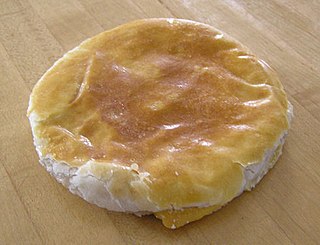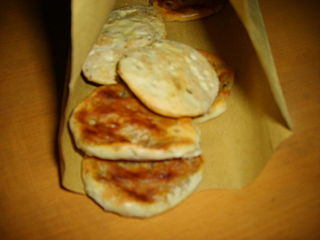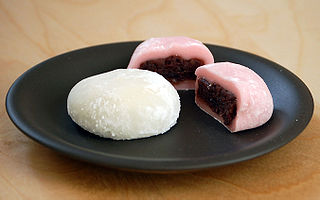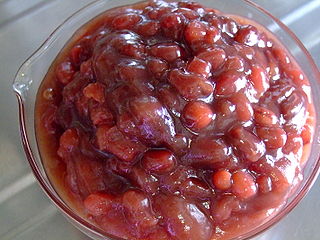
Pastry is baked food made with a dough of flour, water and shortening that may be savoury or sweetened. Sweetened pastries are often described as bakers' confectionery. The word "pastries" suggests many kinds of baked products made from ingredients such as flour, sugar, milk, butter, shortening, baking powder, and eggs. Small tarts and other sweet baked products are called pastries as a synecdoche. Common pastry dishes include pies, tarts, quiches, croissants, and pasties.

Mochi is a Japanese rice cake made of mochigome (もち米), a short-grain japonica glutinous rice, and sometimes other ingredients such as water, sugar, and cornstarch. The steamed rice is pounded into paste and molded into the desired shape. In Japan, it is traditionally made in a ceremony called mochitsuki. While eaten year-round, mochi is a traditional food for the Japanese New Year, and is commonly sold and eaten during that time.

The Mid-Autumn Festival, also known as the Moon Festival or Mooncake Festival, is a traditional festival celebrated in Chinese culture. Similar holidays are celebrated in Japan, Korea, Vietnam, and other countries in East and Southeast Asia.

A mooncake is a Chinese bakery product traditionally eaten during the Mid-Autumn Festival (中秋節). The festival is about lunar appreciation and Moon watching, and mooncakes are regarded as a delicacy. Mooncakes are offered between friends or on family gatherings while celebrating the festival. The Mid-Autumn Festival is widely regarded as one of the four most important Chinese festivals.

A sweetheart cake or wife cake or marriage pie is a traditional Chinese cake with a thin crust of flaky pastry, and made with a filling of winter melon, almond paste, and sesame, and spiced with five spice powder. "Wife cake" is the translation of 老婆饼 from Chinese, and although the meaning is "wife", the literal translation is "old lady cake", paralleling the colloquial usage of "old lady" for "wife" in English. In Hong Kong, it is known as a specialty of Yuen Long.

Popiah is a Fujianese/Teochew-style fresh spring roll filled with an assortment of fresh, dried, and cooked ingredients, eaten during the Qingming Festival and other celebratory occasions. The dish is made by the people and diaspora of Fujian province of Mainland China, neighbouring Chaoshan district, and by the Teochew and Hoklo diaspora in various regions throughout Southeast Asia and in Taiwan, The origin of popiah dates back to the 17th century.

Yukimi Daifuku is a brand of mochi ice cream manufactured by Lotte. It was also released in Japan in October 1981. It consists of a ball of vanilla ice milk wrapped in a thin layer of mochi, or rice cake, bathed in coconut milk. Lotte originally created Watabōshi, a bite-size ice cream wrapped in a thin layer of marshmallow in 1980. Marshmallow was quickly replaced by mochi because it was more popular in Japan and the company perfected a technology to keep mochi soft at freezing temperature in 1981.

Shaobing, also called huoshao, is a type of baked, unleavened, layered flatbread in northern Chinese cuisine. Shaobing can be made with or without stuffing, and with or without sesame on top. Shaobing contains a variety of stuffings that can be grouped into two main flavors: savory or sweet. Some common stuffings include red bean paste, black sesame paste, stir-fried mung beans with egg and tofu, braised beef, smoked meat, or beef or pork with spices.

Mochi ice cream is a confection made from Japanese mochi with an ice cream filling. The filling greatly improves the overall flavor and taste by giving it a creamy sweetness. It was invented by Japanese-American businesswoman and community activist Frances Hashimoto.

Bing is a wheat flour-based Chinese food with a flattened or disk-like shape. These foods may resemble the flatbreads, pancakes, pies and unleavened dough foods of non-Chinese cuisines. Many of them are similar to the Indian roti, French crêpes, Salvadoran pupusa, or Mexican tortilla, while others are more similar to cakes and cookies.

Kompia or kompyang is a bread product that originates from Fuzhou, the capital city of Fujian Province of China as well as Fuqing. It is popular in Fujian and has spread to other areas including the Ryukyus, Taiwan, and parts of Southeast Asia including Indonesia and the Malaysian towns of Sitiawan, Sibu, Ayer Tawar, Sarikei, Bintangor and other places where the dominant Chinese community is of Fuzhou and Fuqing ancestry.

Wing Wah is a Hong Kong based restaurant chain and food manufacturer owned by Wing Wah Food Manufactory Limited (榮華食品製造業有限公司). The company is most renowned for its mooncakes, and also produces: Chinese sausage, cakes, and teas.

Chinese desserts are sweet foods and dishes that are served with tea, along with meals or at the end of meals in Chinese cuisine. The desserts encompass a wide variety of ingredients commonly used in East Asian cuisines such as powdered or whole glutinous rice, sweet bean pastes, and agar. Due to the many Chinese cultures and the long history of China, there are a great variety of desserts of many forms.

Crystal cake is one of the traditional desserts in Weinan city of eastern Shaanxi, China. It has more than 800 years of history. Crystal cake was first invented in Xiagui during the Song Dynasty, then it spread throughout the region. It gets its name from its filling, which is glittering and translucent, like crystal.

Daifukumochi (大福餅), or daifuku (大福), is a wagashi, consisting of a small round mochi stuffed with a sweet filling, most commonly anko,. Daifuku is a popular wagashi in Japan and is often served with green tea.

Red bean paste or red bean jam, also called adzuki bean paste or anko, is a paste made of red beans, used in East Asian cuisine. The paste is prepared by boiling the beans, then mashing or grinding them. At this stage, the paste can be sweetened or left as it is. The color of the paste is usually dark red, which comes from the husk of the beans. In Korean cuisine, the adzuki beans can also be husked prior to cooking, resulting in a white paste. It is also possible to remove the husk by sieving after cooking, but before sweetening, resulting in a red paste that is smoother and more homogeneous.
Yueguangbing, also called moonlight cake, Hakka mooncake, and sometimes referred as Hakka mooncake biscuits or Hakka Moonlight cake in English, is a form of traditional mooncake of Hakka origins. It is a white, flat and disc-like biscuit which typically features carvings and paintings of flowers and animals on its top surface as adornments. It was traditionally used as offerings to the moon on the Mid-Autumn Festival. It is also consumed by the Hakka diaspora and/or people of Chinese and/or Hakka heritage in countries outside of China, such as countries in the regions of Southeast Asia and Africa (Mauritius).



















